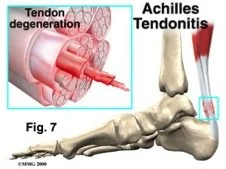10 Fast Facts about Achilles Tendinopathy.
Achilles Tendinopathy is a common overuse injury that is thought be caused by repetitive tiny injuries to the Achilles tendon which is the tendon that joins your heel bone to your calf muscles. When these repeated tiny injuries occur, the tendon does not have a chance to heal completely so over time damage to the Achilles tendon builds up and Achilles Tendinopathy can develop.
People with Achilles Tendinopathy usually complain of a gradual onset of pain and stiffness at the back of the heel. People often find the pain and stiffness is worse in the morning, for example when you first get out of bed, and at the start of exercise. The pain may subside as you warm-up. Sometimes people notice that the Achilles tendon is warm to touch and may also be swollen. Often people with Achilles Tendinopathy find the pain starts as a mild inconvenience and over time becomes quite severe.
Morning pain in the heel of the foot is a hall-mark sign of Achilles Tendinopathy.
Repetitive injury to the Achilles tendon can result from overuse of the tendon and is a common problem for people who run regularly. Wearing inappropriate footwear and having poor training techniques – like rapidly increasing the intensity and frequency of how you train – can also lead to repetitive injury to the Achilles tendon.
Tendons are made up of cells. In the early stages of Achilles Tendinopathy changes occur within the tendon including an increase in cell number and size. In the later stages of Achilles Tendinopathy there can be cell disruption and disorganisation, as well as an increase in blood vessel and nerve formation in the tendon. The changes that occur within the early stages of Tendinopathy can be reversed, however, the more the injury progresses the more permanent the changes may be.
Achilles Tendinopathy used to be known as Achilles Tendonitis. Generally ‘itis’ refers to inflammation, so tendonitis would mean inflammation of the tendon. Achilles Tendinopathy is now thought to be a better term to use because studies show there is little or no inflammation that causes the problem in Achilles Tendinopathy.
Therapeutic exercise is the most evidence based treatment for Achilles Tendinopathy.
You can help yourself! Simple self-management can give short-term relief of Achilles Tendinopathy. Strategies include: rest from aggravating activities, icing the painful area and investing in supportive footwear.
Generally Achilles Tendinopathy does not get completely better on it’s own. Symptoms may improve with rest but once you start doing the aggravating activity again, it’s likely the Achilles tendon will become painful again. Physiotherapy is helpful in addressing pre-disposing factors, reducing pain and stiffness, improving lower limb biomechanics and setting you up with a targeted tendon strengthening program to make the tendon stronger and more accustomed to load.
A graduated tendon loading program is essential in the recovery of Achilles Tendinopathy. Tendons need to be loaded gradually and safely to become stronger and prevent re-injury. Your physiotherapist will tailor an exercise program to you and can progress the exercise program correctly. Getting back on track can take 3 to 12 months depending many factors including symptom duration and severity as well as your adherence to your exercise program. Other treatments may seem like a quick fix and promise faster recovery but no studies have shown better results than progressive therapeutic exercise.


